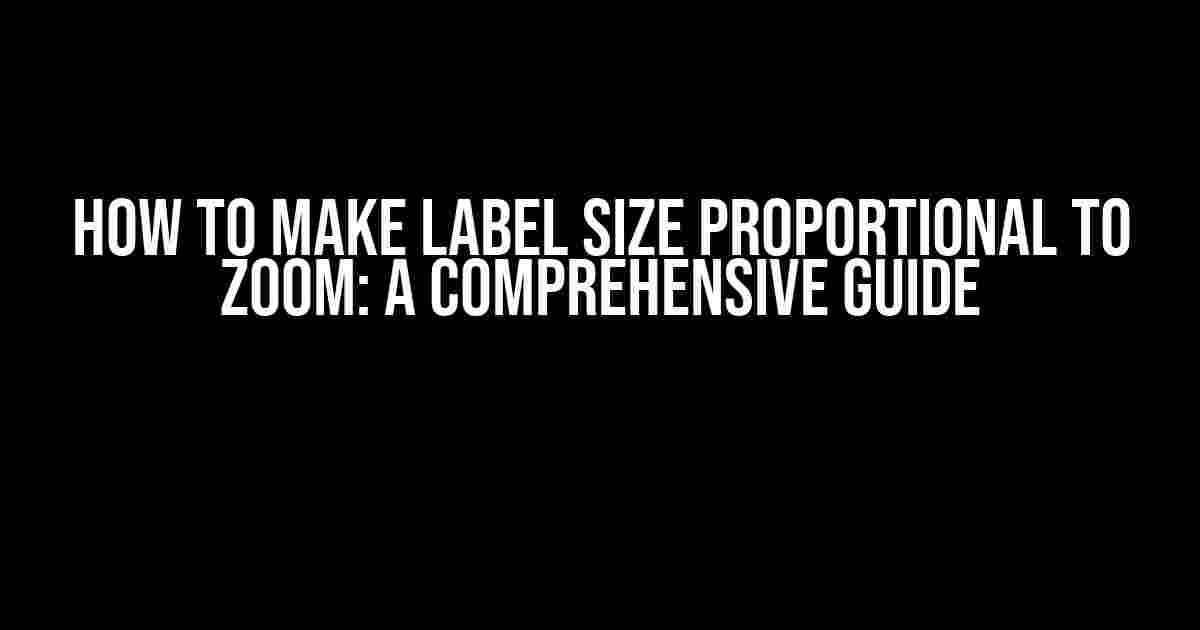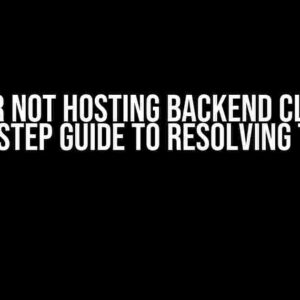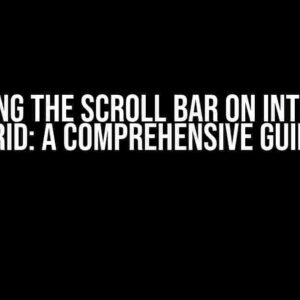Are you tired of dealing with labels that stubbornly refuse to adjust their size in proportion to the zoom level of your application or website? Do you find yourself wrestling with frustrating layouts and inconsistent user experiences? Fear not, dear developer, for we have got you covered! In this extensive guide, we’ll walk you through the steps to make label size proportional to zoom, ensuring a seamless and responsive design that adapts to any device or screen size.
Understanding the Problem
Before we dive into the solution, let’s first understand the root of the issue. When Labels don’t scale proportionally with the zoom level, it can lead to:
- Illegible text at higher zoom levels
- Overlapping or cramped layouts at lower zoom levels
- Inconsistent user experience across different devices and browsers
These issues arise because labels are often set with a fixed font size, which doesn’t adapt to the changing zoom level. To address this, we’ll explore methods to make label size proportional to zoom.
Method 1: Using Relative Font Sizes with CSS
One approach is to use relative font sizes defined in CSS, which can be zoomed in or out by the browser. We’ll use percentage values to set the font size, ensuring it scales proportionally with the zoom level.
label {
font-size: 100%; /* sets font size to 100% of parent element */
}
By setting the font size to 100%, we’re telling the browser to make the label font size equal to the parent element’s font size. This way, when the user zooms in or out, the label size will scale accordingly.
Benefits and Limitations
This method is easy to implement and works well for most cases. However, it has some limitations:
- It only works when the parent element has a defined font size.
- It can be tricky to maintain consistency across different devices and browsers.
Method 2: Using Viewport Units (vw, vh, vmin, vmax)
Another approach is to use viewport units, which are relative to the viewport size. We can set the font size using vw (viewport width) or vh (viewport height) units.
label {
font-size: 2vw; /* sets font size to 2% of viewport width */
}
By using viewport units, we’re making the label size dependent on the viewport’s dimensions. As the user zooms in or out, the label size will adapt proportionally.
Benefits and Limitations
This method provides more control over the font size and is more flexible than relative font sizes. However, it has some limitations:
- It can be affected by the device’s pixel density.
- It may not work correctly in older browsers.
Method 3: Using JavaScript and the Zoom Event
For more complex scenarios or when you need precise control over the label size, you can use JavaScript to monitor the zoom event and adjust the font size accordingly.
// get the initial font size
var initialFontSize = 16;
// monitor the zoom event
document.addEventListener('wheel', function(event) {
// get the current zoom level
var zoomLevel = event.deltaY > 0 ? 1.1 : 0.9;
// calculate the new font size
var newFontSize = initialFontSize * zoomLevel;
// set the new font size
document.querySelectorAll('label').forEach(function(label) {
label.style.fontSize = newFontSize + 'px';
});
});
This method provides the most control over the label size, but it requires more code and can be more complex to implement.
Benefits and Limitations
This method offers the most flexibility and control, but it has some limitations:
- It requires JavaScript to be enabled.
- It may not work correctly in older browsers or devices with limited JavaScript support.
Conclusion
Making label size proportional to zoom is a crucial aspect of designing responsive and user-friendly applications and websites. By using relative font sizes, viewport units, or JavaScript and the zoom event, you can ensure a seamless user experience across different devices and screen sizes. Remember to weigh the benefits and limitations of each method and choose the one that best suits your project’s requirements.
| Method | Benefits | Limitations |
|---|---|---|
| Relative Font Sizes | Easy to implement, works well for most cases | Requires parent element to have defined font size, may not maintain consistency across devices and browsers |
| Viewport Units | Provides more control over font size, flexible | Affected by pixel density, may not work correctly in older browsers |
| JavaScript and Zoom Event | Offers most control, flexible | Requires JavaScript to be enabled, may not work correctly in older browsers or devices with limited JavaScript support |
By following these methods and understanding their benefits and limitations, you’ll be well on your way to creating responsive and user-friendly designs that adapt to any device or screen size.
Final Thoughts
Remember, making label size proportional to zoom is just one aspect of designing a responsive and user-friendly interface. Continuously test and iterate on your design to ensure a seamless user experience across different devices and screen sizes.
With this comprehensive guide, you’re now equipped with the knowledge to tackle the challenge of making label size proportional to zoom. Go forth and create interfaces that delight and amaze your users!
Frequently Asked Question
Get the scoop on how to make label size proportional to zoom!
Why is my label size not changing with zoom?
Hey there! If your label size isn’t adjusting to zoom, it’s probably because you haven’t set the label’s scaleWithZoom property to true. Super easy fix! Just toggle that switch, and your labels will resize accordingly.
How do I set the label size to be proportional to zoom?
To make label size proportional to zoom, you’ll want to use a combination of CSS and JavaScript magic! Set the label’s font size using a viewport unit (like vw or vh), and then use JavaScript to update the font size based on the zoom level. Voilà!
What’s the best way to achieve responsive label sizing?
For responsive label sizing, we recommend using a CSS-only approach with relative units like em or rem. This way, your labels will automatically adjust to the zoom level and font size of the surrounding text. Easy peasy!
Can I use a library or framework to make label sizing easier?
You bet! There are plenty of libraries and frameworks that can help you with label sizing, such as D3.js or Chart.js. These tools often provide built-in functionality for responsive label sizing, so you can focus on more important things… like sipping that latte!
What if I want to customize the label size for different zoom levels?
If you want to get fancy and customize label sizes for specific zoom levels, you can use JavaScript to listen for zoom events and update the label sizes accordingly. It might take some extra coding, but the flexibility is worth it!





